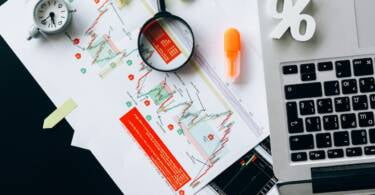There is almost undoubtedly no industry more nervy and superstitious than finance. In no other industry does bad news spread like wild fire, wiping a fortune off its value with just a careless whisper of the word, “downturn”…
Bad news, true or not, sends panic and disarray through the financial markets at a rate so fast a bankers freshly purchased Bugatti Veyron would struggle to keep up.
So, what do economists and financial analysts do to stay ahead and keep profits healthy regardless of what the markets are doing, to ensure they’re not caught out investing where they shouldn’t?
There are a number of standard sensible measures, such as keeping an eye on the commodities markets. Commodity markets are the markets selling raw goods, the stuff we use to make consumable stuff such as oil, metals, even wheat. If manufacturers are buying lots of commodities, it shows the demand for their goods is increasing, consumers are buying more and confidence is up. This is a good sign all is rosy with the economy.
Interest rates are another good indicator. We’re currently in a period of globally historically low rates, they’ve never been this low for this long. But low interest rates aren’t an indicator of a healthy economy. In fact the only reason they’ve been this low for so long is that central banks are worried about upsetting the fragile recovery.
GDP, gross domestic product, the measure of all the goods and services produced by a country also gives economists an idea of how the economy is doing. High GDP equals lots of production, which in turns means high employment, high consumer confidence and spending, high government tax receipts and high government investment, we all love a healthy GDP figure!
But what about the other, less scientific measures? What about, for instance, the lipstick indicator?
Lipstick indicator
Back in 2001, after the 9/11 attacks, Estee Lauder lipstick sales jumped 11% despite a fall in global confidence. In 2008, at the start of the global downturn, L’Oreal posted sales growth of 5.3%, and Avon reported a rise in sales as well. The thinking behind this? In times of economic crisis, when consumers are cutting costs as much as possible, they still need a little pick me up. For women, its make up.
Men, however, seem to choose the less glamourous tie as their pick me up of choice.
Yes, apparently so. In a similar fashion to the increase in make up sales, in times of economic strife, the sales of ties go up. Whether it’s just a cheaper way to jazz up a suit, a similar boost to buying make up for a woman, or because the increased threat to jobs means appearance suddenly matters more, who knows. But economists have known for years now, there is a correlation between economic slow down and increased tie sales.
And fashion provides yet another economic indicator, the hemline indicator. The theory goes that the shorter the skirt, the better the times, economically speaking of course! Roaring 20’s, economic boom time and the fashionable and daring were wearing skirts so short it put their Victorian grandmothers in their graves. The economic woes of the 70’s brought hemlines crashing back down to ankle length, and as the good times returned in the 80’s boom period, as wages and stock markets soared, so did hemlines.
Hemlines
As strange as these less scientific measures may sound, there is some method to their madness. Economics is much more than just formulas and figures, it’s about human behaviour and emotion. In fact, it’s about the most fragile of human emotion, confidence, something that can be destroyed in seconds with a stray word and yet take an eternity to rebuild.
These indicators show how confident we are, how happy we are to spend our money. Do we feel secure enough financially and in our jobs to spend big, or do we need to reign our spending in. But while reigning it in, do we feel so low that we guiltily indulge in an expensive treat?
So where do these indicators point at the moment? Well the commodities markets aren’t doing too well. The UK has just seen the mothballing of the SSI iron and steel making plant in Redcar due to global over supply, and oil is worth roughly half its value from last year. Prestige make up sales are up 14.3% on this period last year and the fashionable hemline? Mid-calf to ankle length.
Looks like we might be in for yet another economic bumpy ride.
What do you think? Have your say in the comments below.








